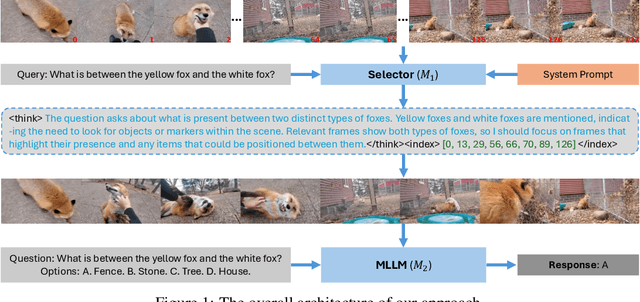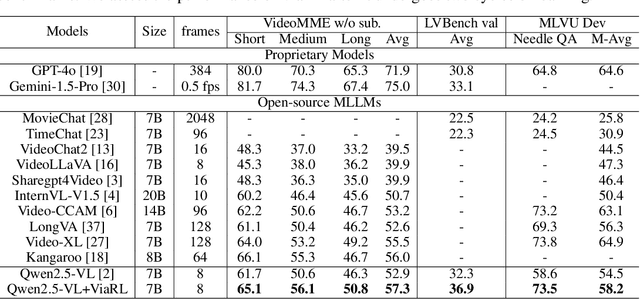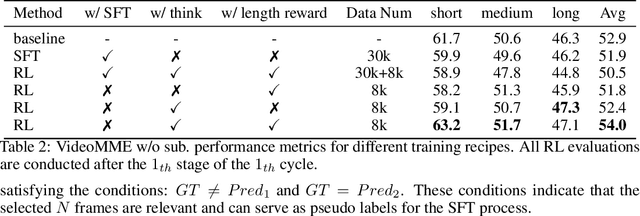Chong Luo
StableAvatar: Infinite-Length Audio-Driven Avatar Video Generation
Aug 11, 2025Abstract:Current diffusion models for audio-driven avatar video generation struggle to synthesize long videos with natural audio synchronization and identity consistency. This paper presents StableAvatar, the first end-to-end video diffusion transformer that synthesizes infinite-length high-quality videos without post-processing. Conditioned on a reference image and audio, StableAvatar integrates tailored training and inference modules to enable infinite-length video generation. We observe that the main reason preventing existing models from generating long videos lies in their audio modeling. They typically rely on third-party off-the-shelf extractors to obtain audio embeddings, which are then directly injected into the diffusion model via cross-attention. Since current diffusion backbones lack any audio-related priors, this approach causes severe latent distribution error accumulation across video clips, leading the latent distribution of subsequent segments to drift away from the optimal distribution gradually. To address this, StableAvatar introduces a novel Time-step-aware Audio Adapter that prevents error accumulation via time-step-aware modulation. During inference, we propose a novel Audio Native Guidance Mechanism to further enhance the audio synchronization by leveraging the diffusion's own evolving joint audio-latent prediction as a dynamic guidance signal. To enhance the smoothness of the infinite-length videos, we introduce a Dynamic Weighted Sliding-window Strategy that fuses latent over time. Experiments on benchmarks show the effectiveness of StableAvatar both qualitatively and quantitatively.
Phi-Ground Tech Report: Advancing Perception in GUI Grounding
Jul 31, 2025



Abstract:With the development of multimodal reasoning models, Computer Use Agents (CUAs), akin to Jarvis from \textit{"Iron Man"}, are becoming a reality. GUI grounding is a core component for CUAs to execute actual actions, similar to mechanical control in robotics, and it directly leads to the success or failure of the system. It determines actions such as clicking and typing, as well as related parameters like the coordinates for clicks. Current end-to-end grounding models still achieve less than 65\% accuracy on challenging benchmarks like ScreenSpot-pro and UI-Vision, indicating they are far from being ready for deployment. % , as a single misclick can result in unacceptable consequences. In this work, we conduct an empirical study on the training of grounding models, examining details from data collection to model training. Ultimately, we developed the \textbf{Phi-Ground} model family, which achieves state-of-the-art performance across all five grounding benchmarks for models under $10B$ parameters in agent settings. In the end-to-end model setting, our model still achieves SOTA results with scores of \textit{\textbf{43.2}} on ScreenSpot-pro and \textit{\textbf{27.2}} on UI-Vision. We believe that the various details discussed in this paper, along with our successes and failures, not only clarify the construction of grounding models but also benefit other perception tasks. Project homepage: \href{https://zhangmiaosen2000.github.io/Phi-Ground/}{https://zhangmiaosen2000.github.io/Phi-Ground/}
ReasonGen-R1: CoT for Autoregressive Image generation models through SFT and RL
May 30, 2025Abstract:Although chain-of-thought reasoning and reinforcement learning (RL) have driven breakthroughs in NLP, their integration into generative vision models remains underexplored. We introduce ReasonGen-R1, a two-stage framework that first imbues an autoregressive image generator with explicit text-based "thinking" skills via supervised fine-tuning on a newly generated reasoning dataset of written rationales, and then refines its outputs using Group Relative Policy Optimization. To enable the model to reason through text before generating images, We automatically generate and release a corpus of model crafted rationales paired with visual prompts, enabling controlled planning of object layouts, styles, and scene compositions. Our GRPO algorithm uses reward signals from a pretrained vision language model to assess overall visual quality, optimizing the policy in each update. Evaluations on GenEval, DPG, and the T2I benchmark demonstrate that ReasonGen-R1 consistently outperforms strong baselines and prior state-of-the-art models. More: aka.ms/reasongen.
ViaRL: Adaptive Temporal Grounding via Visual Iterated Amplification Reinforcement Learning
May 21, 2025



Abstract:Video understanding is inherently intention-driven-humans naturally focus on relevant frames based on their goals. Recent advancements in multimodal large language models (MLLMs) have enabled flexible query-driven reasoning; however, video-based frameworks like Video Chain-of-Thought lack direct training signals to effectively identify relevant frames. Current approaches often rely on heuristic methods or pseudo-label supervised annotations, which are both costly and limited in scalability across diverse scenarios. To overcome these challenges, we introduce ViaRL, the first framework to leverage rule-based reinforcement learning (RL) for optimizing frame selection in intention-driven video understanding. An iterated amplification strategy is adopted to perform alternating cyclic training in the video CoT system, where each component undergoes iterative cycles of refinement to improve its capabilities. ViaRL utilizes the answer accuracy of a downstream model as a reward signal to train a frame selector through trial-and-error, eliminating the need for expensive annotations while closely aligning with human-like learning processes. Comprehensive experiments across multiple benchmarks, including VideoMME, LVBench, and MLVU, demonstrate that ViaRL consistently delivers superior temporal grounding performance and robust generalization across diverse video understanding tasks, highlighting its effectiveness and scalability. Notably, ViaRL achieves a nearly 15\% improvement on Needle QA, a subset of MLVU, which is required to search a specific needle within a long video and regarded as one of the most suitable benchmarks for evaluating temporal grounding.
Efficient RL Training for Reasoning Models via Length-Aware Optimization
May 18, 2025Abstract:Large reasoning models, such as OpenAI o1 or DeepSeek R1, have demonstrated remarkable performance on reasoning tasks but often incur a long reasoning path with significant memory and time costs. Existing methods primarily aim to shorten reasoning paths by introducing additional training data and stages. In this paper, we propose three critical reward designs integrated directly into the reinforcement learning process of large reasoning models, which reduce the response length without extra training stages. Experiments on four settings show that our method significantly decreases response length while maintaining or even improving performance. Specifically, in a logic reasoning setting, we achieve a 40% reduction in response length averaged by steps alongside a 14% gain in performance. For math problems, we reduce response length averaged by steps by 33% while preserving performance.
JointDiT: Enhancing RGB-Depth Joint Modeling with Diffusion Transformers
May 01, 2025Abstract:We present JointDiT, a diffusion transformer that models the joint distribution of RGB and depth. By leveraging the architectural benefit and outstanding image prior of the state-of-the-art diffusion transformer, JointDiT not only generates high-fidelity images but also produces geometrically plausible and accurate depth maps. This solid joint distribution modeling is achieved through two simple yet effective techniques that we propose, i.e., adaptive scheduling weights, which depend on the noise levels of each modality, and the unbalanced timestep sampling strategy. With these techniques, we train our model across all noise levels for each modality, enabling JointDiT to naturally handle various combinatorial generation tasks, including joint generation, depth estimation, and depth-conditioned image generation by simply controlling the timestep of each branch. JointDiT demonstrates outstanding joint generation performance. Furthermore, it achieves comparable results in depth estimation and depth-conditioned image generation, suggesting that joint distribution modeling can serve as a replaceable alternative to conditional generation. The project page is available at https://byungki-k.github.io/JointDiT/.
Subject-driven Video Generation via Disentangled Identity and Motion
Apr 23, 2025Abstract:We propose to train a subject-driven customized video generation model through decoupling the subject-specific learning from temporal dynamics in zero-shot without additional tuning. A traditional method for video customization that is tuning-free often relies on large, annotated video datasets, which are computationally expensive and require extensive annotation. In contrast to the previous approach, we introduce the use of an image customization dataset directly on training video customization models, factorizing the video customization into two folds: (1) identity injection through image customization dataset and (2) temporal modeling preservation with a small set of unannotated videos through the image-to-video training method. Additionally, we employ random image token dropping with randomized image initialization during image-to-video fine-tuning to mitigate the copy-and-paste issue. To further enhance learning, we introduce stochastic switching during joint optimization of subject-specific and temporal features, mitigating catastrophic forgetting. Our method achieves strong subject consistency and scalability, outperforming existing video customization models in zero-shot settings, demonstrating the effectiveness of our framework.
HiTVideo: Hierarchical Tokenizers for Enhancing Text-to-Video Generation with Autoregressive Large Language Models
Mar 14, 2025Abstract:Text-to-video generation poses significant challenges due to the inherent complexity of video data, which spans both temporal and spatial dimensions. It introduces additional redundancy, abrupt variations, and a domain gap between language and vision tokens while generation. Addressing these challenges requires an effective video tokenizer that can efficiently encode video data while preserving essential semantic and spatiotemporal information, serving as a critical bridge between text and vision. Inspired by the observation in VQ-VAE-2 and workflows of traditional animation, we propose HiTVideo for text-to-video generation with hierarchical tokenizers. It utilizes a 3D causal VAE with a multi-layer discrete token framework, encoding video content into hierarchically structured codebooks. Higher layers capture semantic information with higher compression, while lower layers focus on fine-grained spatiotemporal details, striking a balance between compression efficiency and reconstruction quality. Our approach efficiently encodes longer video sequences (e.g., 8 seconds, 64 frames), reducing bits per pixel (bpp) by approximately 70\% compared to baseline tokenizers, while maintaining competitive reconstruction quality. We explore the trade-offs between compression and reconstruction, while emphasizing the advantages of high-compressed semantic tokens in text-to-video tasks. HiTVideo aims to address the potential limitations of existing video tokenizers in text-to-video generation tasks, striving for higher compression ratios and simplify LLMs modeling under language guidance, offering a scalable and promising framework for advancing text to video generation. Demo page: https://ziqinzhou66.github.io/project/HiTVideo.
Phi-4-Mini Technical Report: Compact yet Powerful Multimodal Language Models via Mixture-of-LoRAs
Mar 03, 2025Abstract:We introduce Phi-4-Mini and Phi-4-Multimodal, compact yet highly capable language and multimodal models. Phi-4-Mini is a 3.8-billion-parameter language model trained on high-quality web and synthetic data, significantly outperforming recent open-source models of similar size and matching the performance of models twice its size on math and coding tasks requiring complex reasoning. This achievement is driven by a carefully curated synthetic data recipe emphasizing high-quality math and coding datasets. Compared to its predecessor, Phi-3.5-Mini, Phi-4-Mini features an expanded vocabulary size of 200K tokens to better support multilingual applications, as well as group query attention for more efficient long-sequence generation. Phi-4-Multimodal is a multimodal model that integrates text, vision, and speech/audio input modalities into a single model. Its novel modality extension approach leverages LoRA adapters and modality-specific routers to allow multiple inference modes combining various modalities without interference. For example, it now ranks first in the OpenASR leaderboard to date, although the LoRA component of the speech/audio modality has just 460 million parameters. Phi-4-Multimodal supports scenarios involving (vision + language), (vision + speech), and (speech/audio) inputs, outperforming larger vision-language and speech-language models on a wide range of tasks. Additionally, we experiment to further train Phi-4-Mini to enhance its reasoning capabilities. Despite its compact 3.8-billion-parameter size, this experimental version achieves reasoning performance on par with or surpassing significantly larger models, including DeepSeek-R1-Distill-Qwen-7B and DeepSeek-R1-Distill-Llama-8B.
Logic-RL: Unleashing LLM Reasoning with Rule-Based Reinforcement Learning
Feb 20, 2025Abstract:Inspired by the success of DeepSeek-R1, we explore the potential of rule-based reinforcement learning (RL) in large reasoning models. To analyze reasoning dynamics, we use synthetic logic puzzles as training data due to their controllable complexity and straightforward answer verification. We make some key technical contributions that lead to effective and stable RL training: a system prompt that emphasizes the thinking and answering process, a stringent format reward function that penalizes outputs for taking shortcuts, and a straightforward training recipe that achieves stable convergence. Our 7B model develops advanced reasoning skills-such as reflection, verification, and summarization-that are absent from the logic corpus. Remarkably, after training on just 5K logic problems, it demonstrates generalization abilities to the challenging math benchmarks AIME and AMC.
 Add to Chrome
Add to Chrome Add to Firefox
Add to Firefox Add to Edge
Add to Edge